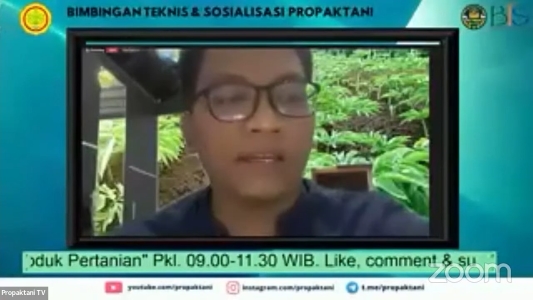IPB University Academics Explain Porang Cultivation as an Alternative to Farming and Land Optimization Efforts

Village communities, especially youth, need to be encouraged to be more active and effective in carrying out food-planting, plantation, and other cultivation businesses. The majority of the community are farmers who need to be empowered from the initial stage to post-harvest to increase the economic value of the village.
Misrudin, Lecturer and Coordinator of the Department of Social Affairs Alumni Association (HA) for the Postgraduate Program in Natural Resources and Environment Management (PSL) IPB University, recommends porang cultivation as an effort to optimize land for added economic value of the village.
He explained, porang can be used as an alternative type of plant as a food source. This is because porang tubers have a fairly high nutritional value, namely a starch content of 76.5 percent, 9.20 percent protein, and 25 percent fibre content. Porang is also low in fat, the content is only 0.20 percent.
“The growing conditions for porang plants can generally grow anywhere. However, its growth will be more optimal if it’s planted in ideal climate, soil, and environmental conditions," he said in the Propaktani Technical Guidance and Socialization entitled 'Profitable Farming Business' as a result of collaboration between Ecologica PSL IPB University and the Directorate General of Food Crops, Ministry of Agriculture of the Republic of Indonesia online (14/03).
"As an example, porang cultivation technology on Ternau land can support good growth. The land used is located under stands of forest plants and land preparation at the end of the dry season to produce an ideal growing environment," he continued. He said, porang planting material can be selected from superior varieties or other varieties in the form of bulbils or frogs, tubers, seeds, or tissue culture results. He explained, the distance of planting, depending on the planting material used. Fertilizers used also vary, can be with dolomite, nitrogen fertilizers, or manure.
"The main disease of porang plants is stem rot disease caused by Sclerotium rolfsii and Cercospora sp. leaf spot. Pest and disease control is carried out in an integrated manner by integrating mechanical control, the use of plant-based pesticides and natural enemies," he said.
Apart from Ternau land, he added, porang can also be cultivated in open land. Porang can grow optimally in open land with a height above 400 meters above sea level. Planting below this altitude requires environmental modification with paranets and adequate water availability because it is sensitive to drought.
In open conditions, he said, cultivation land for porang plants must be prepared at the end of the dry season. This is important to produce a better growing environment and optimal growth.
“The land is cleared of grass in a conventional way with a scythe or mechanically with a lawn mower. Herbicides are only used when weed conditions are classified as severe," he concluded. (MW/Zul) (IAAS/MKY)


